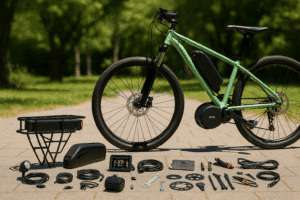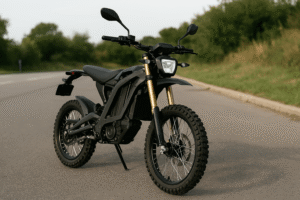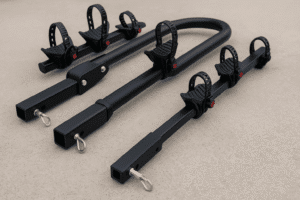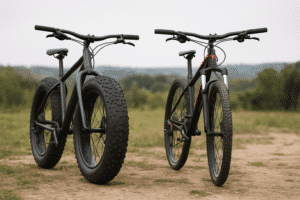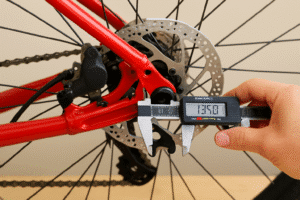If you’re wondering how old you have to be to ride an electric bike, the short answer is this: it depends on where you live and what kind of e-bike you’re riding.
Most U.S. states set the minimum age between 14 and 16, with stricter rules for faster models.
In this guide, we’ll break it all down so you know exactly what’s legal and what’s safe.
Key Takeaways:
- Most states set the minimum age to ride an e-bike between 14 and 16 years old.
- Class 3 e-bikes (up to 28 mph) typically require the rider to be at least 16.
- E-bike age laws vary by state and bike class, so always check local rules.
- Parents may be held legally responsible if a child rides underage or unsafely.
Why Age Requirements for E-Bikes Matter
Most states set the legal minimum age for riding an e-bike between 14 and 16 to reduce the risk of crashes and injuries. These rules exist to make sure riders are physically ready and understand how to stay safe on the road.
E-bikes may look like regular bikes, but they ride more like small motor vehicles.
With pedal assist or throttle systems, some models can hit 28 mph, which calls for stronger reflexes and better awareness than you’d expect from a casual cruiser.
Younger kids may not have the coordination, size, or maturity to handle them safely.
Setting an age limit also protects others on the road. Just like with scooters and mopeds, states want riders to be old enough to understand the rules, make quick decisions, and avoid putting themselves or others in danger.
How Old Do You Have to Be to Ride an Electric Bike?
In most states, you have to be at least 14 to 16 years old to ride an electric bike legally. Some areas allow younger riders on low-speed models, while others have stricter rules for faster bikes.
There’s no single national rule, so the age limit depends on two things: your local laws and the class of e-bike you’re using. Class 1 and Class 2 e-bikes, which top out at 20 mph, are usually allowed for younger teens.
But Class 3 bikes, which go up to 28 mph, almost always require the rider to be 16 or older.
Keep in mind that some states also require helmets, and a few restrict kids from using throttle-powered e-bikes entirely.
If you’re a parent, it’s smart to check your state’s DMV or Department of Transportation website for up-to-date rules.
E-Bike Classifications and Age Restrictions
E-bike age limits depend heavily on the bike’s class. Here’s how each one works and what restrictions usually come with it.
Class 1 – Pedal Assist (Up to 20 MPH)
Class 1 e-bikes use a motor that kicks in only when you pedal, and they stop assisting once you reach 20 mph. These are usually treated the same as regular bikes in most states.
Many states allow riders as young as 14 to use Class 1 e-bikes. Because there’s no throttle and the speed is limited, they’re often seen as the safest entry-level option for teens.
Some places still require helmets for riders under 18.
Class 2 – Throttle + Pedal Assist (Up to 20 MPH)
Class 2 bikes add a throttle, so you can ride without pedaling. They still cap out at 20 mph but offer more power and control with less effort.
Some states restrict throttle use for younger riders, even if the top speed is the same as Class 1. Others allow it but require parental supervision or limit where kids can ride, like keeping them off major roads or bike lanes.
The age limit is often 14 or 15, but this varies by location.
Class 3 – Pedal Assist (Up to 28 MPH)
Class 3 e-bikes are faster and more powerful. They only assist when pedaling but can reach speeds up to 28 mph. This makes them better suited for older teens and adults who understand road safety.
Most states require riders to be at least 16 to operate a Class 3 e-bike. Helmet use is often mandatory, and some areas ban these bikes from certain paths or trails.
Class 3 bikes are treated more like mopeds in terms of legal restrictions.
Federal vs. State E-Bike Age Laws
There is no single federal age requirement for riding an electric bike in the U.S., each state sets its own rules. The federal government defines e-bikes by class but does not control who can ride them.
Under federal guidelines, Class 1, 2, and 3 e-bikes are categorized as “low-speed electric bicycles” if they have a motor under 750 watts and follow certain speed limits. This helps manufacturers and retailers with labeling and compliance.
However, actual riding laws, like age limits, helmet use, and licensing, are decided by individual states. That’s why a 14-year-old might be allowed to ride in one state, but not in another.
So if you’re unsure about the rules where you live, your best bet is to check your local DMV or Department of Transportation website. It only takes a minute and can save you a lot of trouble.
What Happens if You Ride an E-Bike Underage?
If you ride an e-bike before you’re legally allowed, you might face a warning, a fine, or even have your bike taken away. Some states may also hold parents or guardians accountable.
But it’s not just about breaking the law. If an underage rider gets into an accident, insurance may not cover the damage or medical costs.
That can lead to costly out-of-pocket bills or legal problems, especially if others are involved. It’s one of those cases where it’s better to be safe, and legal, than sorry.
Safety Tips for Parents of Young E-Bike Riders
Even if your state allows younger riders, safety should still come first. Here are a few practical ways to keep kids safer on electric bikes:
- Start with the right bike: Choose a Class 1 model with limited speed and no throttle. It’s easier to control and better for beginners.
- Make helmets non-negotiable: No ride without one. Bonus points for gloves, knee pads, and reflective gear.
- Stick to safe routes: Neighborhood streets, bike paths, or open parks are better than busy roads or shared lanes.
- Ride together at first: Supervise early rides and teach road rules in real time.
- Set clear rules: Decide where, when, and how far your child is allowed to ride, especially if they’ll be out without you.
- Do regular maintenance checks: Make sure brakes work, tires are inflated, and lights are functional before each ride.
Do Kids Need a License to Ride an E-Bike?
In most states, kids do not need a driver’s license to ride Class 1 or Class 2 electric bikes. These e-bikes are usually treated like traditional bicycles under state law.
That said, some Class 3 bikes (especially those that go up to 28 mph) may require a license or permit in certain areas.
A few states also treat throttle-based e-bikes more like mopeds, which could trigger license or registration requirements.
Again, the key is knowing how your state classifies the bike and what rules apply.
Final Words
So, how old do you have to be to ride an electric bike? For most states, it’s somewhere between 14 and 16, but that depends on the bike’s class and your local laws.
Class 1 and Class 2 e-bikes are usually more flexible for younger teens, while Class 3 models often come with stricter rules.
E-bikes are fun, fast, and practical, but they’re not toys. Make sure the rider is ready, the rules are clear, and safety comes first.
A little planning goes a long way in keeping your ride smooth and your record clean.
FAQs
Can a 13-year-old ride an electric bike?
In most states, 13-year-olds are not legally allowed to ride electric bikes, especially Class 2 or Class 3 models. Some areas may allow it with adult supervision on private property, but public road use usually requires the rider to be at least 14 or older.
Is there a legal age to ride a Class 2 e-bike?
Yes, many states set a minimum age of 14 or 15 for Class 2 e-bikes, which have a throttle function. Some states may also require helmet use or restrict younger riders to certain areas.
Can kids ride e-bikes on sidewalks?
Sidewalk rules vary by city and state. In some places, kids can ride e-bikes on sidewalks, but others ban all motorized vehicles, even low-speed ones, from pedestrian areas.
What happens if a minor crashes on an e-bike?
If a minor crashes on an e-bike, legal and insurance issues can arise, especially if the rider is under the legal age or the bike is not street-legal. Parents may be held liable for damages or medical costs.
Is adult supervision required for minors on e-bikes?
Adult supervision is not always legally required, but it is strongly recommended for riders under 16. Some local laws may mandate adult oversight, especially for younger riders using throttle-powered or faster bikes.
Al Amin Morshed is the founder of BoltBikers and a seasoned e-bike reviewer with years of hands-on experience testing electric bikes. As a long-time e-bike enthusiast, he combines real-world riding insights with in-depth research to create honest, helpful content for riders of all levels. Through BoltBikers, Morshed aims to make e-biking more accessible, practical, and enjoyable – whether you’re a new rider or a daily commuter looking for the best gear.
